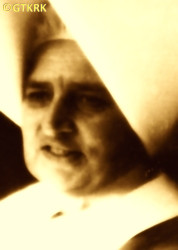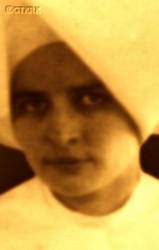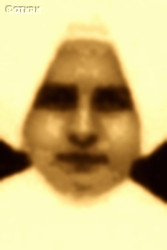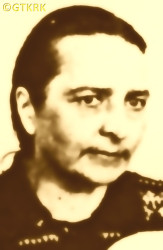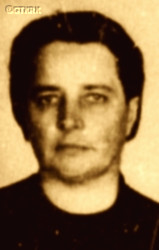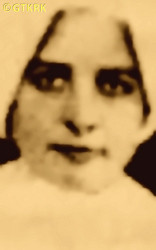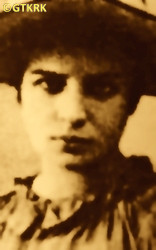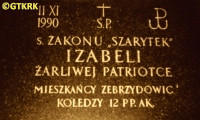Roman Catholic
St Sigismund parish
05-507 Słomczyn
85 Wiślana Str.
Konstancin deanery
Warsaw archdiocese, Poland
full list:
displayClick to display full list

searchClick to search full list by categories
wyświetlKliknij by wyświetlić pełną listę po polsku

szukajKliknij by przeszukać listę wg kategorii po polsku

Martyrology of the clergy — Poland
XX century (1914 – 1989)
personal data
religious status
Servant of God
surname
ŁUSZCZKIEWICZ
forename(s)
Sophia Mary (pl. Zofia Maria)
religious forename(s)
Isabel (pl. Izabela)
function
nun
creed
Latin (Roman Catholic) Church RCmore on
en.wikipedia.org
[access: 2014.09.21]
congregation
Congregation of the Daughters of Charity of Saint Vincent de Paul FdlCmore on
en.wikipedia.org
[access: 2013.05.19]
(i.e. Daughters of Charity)
date and place
of death
08.08.1957

Krakówtoday: Kraków city pov., Lesser Poland voiv., Poland
more on
en.wikipedia.org
[access: 2021.06.07]
details of death
During Polish–Russian war of 1919‐1921 volunteer nurse in Polish Army.
After German and Russian invasion in 09.1939 and start of the World War II wanted by the Russian NKVD in Lviv.
Went into hiding.
Illegally crossed over the border set up by the two occupiers and went to German‐run Germ. Generalgouvernement (Eng. General Governorate), to native Kraków.
Ministered in Zebrzydowice Congregation's house.
Took care of needy.
Participated in efforts to save persecuted Jews.
Collaborated with Polish clandestine resistance Home Army AK and Peasants battalions BCh, part of Polish Clandestine State.
Run nursing courses for partisans.
Hid partisans in the Congregation's house.
In 09.1944 narrowly avoided arrest when Germans search the house and found Mr Bruno Olbrycht, nom‐de‐guerre „Olza”, head of „Śląsk Cieszyński” partisan unit.
After start of Russian occupation still supported independence clandestine „Freedom and Independence” WiN movement.
Took care of wounded soldiers, helped them to escape from Commie‐Nazi UB units, part of Russian NKVD.
In danger of imminent danger moved back on 16.08.1946 to Kraków and next on 24.05.1947 to Zebrzydowice.
Arrested by the Commie‐Nazis on 27.08.1948 in Wadowice, where was summoned under false pretenses.
Jailed in Kraków, in police jail and next in Montelupich prison.
On 23.09.1948 transported to Rakowiecka prison in Warsaw.
Tortured, beaten up senseless.
Did not reveal anything.
On 13.03.1950 sentenced by the Commie‐Nazis thrice to death.
For three months kept in death cell.
On 10.05.1950 sentence changed to life imprisonment.
Jailed in Fordon (twice: 1950‐1952, 1955‐1956) and Inowrocław prisons (1952‐1955), including 13 months in isolation in the latter one (she described this prison later as „Polish KL Auschwitz”).
Conditionally released on 05.05.1956.
Terminally ill — leg tuberculosis contracted in prison, cancer of jaws at places where had teeth punched out by Commie‐Nazis during interrogations — perished soon without recovering.
cause of death
extermination
perpetrators
Russians / Poles
sites and events
InowrocławClick to display the description, Fordon (prison)Click to display the description, Warsaw (Mokotów)Click to display the description, Cracow (Montelupich)Click to display the description, Help to the JewsClick to display the description, GeneralgouvernementClick to display the description, Reichsgau Danzig‐WestpreußenClick to display the description, Ribbentrop‐MolotovClick to display the description, Pius XI's encyclicalsClick to display the description, Polish‐Russian war of 1919‐1921Click to display the description
date and place
of birth
23.04.1898

Krakówtoday: Kraków city pov., Lesser Poland voiv., Poland
more on
en.wikipedia.org
[access: 2021.06.07]
parents
ŁUSZCZKIEWICZ Michael
🞲 ?, ? — 🕆 ?, ?

ŁAKOCIŃSKA Casimira
🞲 ?, ? — 🕆 ?, ?
religious vows
08.09.1928 (last)
positions held
1947 – 1948
nun — Zebrzydowicetoday: Kalwaria Zebrzydowska gm., Wadowice pov., Lesser Poland voiv., Poland
more on
en.wikipedia.org
[access: 2021.12.18] ⋄ Congregation's house, Daughters of Charity FdlC — head of an orphanage
1946 – 1947
nun — Krakówtoday: Kraków city pov., Lesser Poland voiv., Poland
more on
en.wikipedia.org
[access: 2021.06.07] ⋄ provincial house, Daughters of Charity FdlC
1944 – 1946
nun — Rzeszówtoday: Rzeszów city pov., Subcarpathia voiv., Poland
more on
en.wikipedia.org
[access: 2021.06.07] ⋄ Congregation's house, Daughters of Charity FdlC — nurse at Public Hospital at 2 Szopen Str.
1940 – 1944
nun — Zebrzydowicetoday: Kalwaria Zebrzydowska gm., Wadowice pov., Lesser Poland voiv., Poland
more on
en.wikipedia.org
[access: 2021.12.18] ⋄ Congregation's house, Daughters of Charity FdlC
1926 – 1939
nun — Lvivtoday: Lviv urban hrom., Lviv rai., Lviv obl., Ukraine
more on
en.wikipedia.org
[access: 2022.01.16] ⋄ Congregation's house (at the former Reformed Franciscans' monastery by St Casimir church), Daughters of Charity FdlC — director of the Nursing School by the General State Hospital
1925 – 1926
nun — Paristoday: Paris dep., Île‐de‐France reg., France
more on
en.wikipedia.org
[access: 2020.11.13] ⋄ Motherhouse, Daughters of Charity FdlC — student of the College of Nursing
1924 – 1925
nun — Bordeauxtoday: Bordeaux arr., Gironde dep., Nouvelle‐Aquitaine reg., France
more on
en.wikipedia.org
[access: 2022.09.17] ⋄ Congregation's house, Daughters of Charity FdlC — nursing practice
1923 – 1924
novitiate — Paristoday: Paris dep., Île‐de‐France reg., France
more on
en.wikipedia.org
[access: 2020.11.13] ⋄ Motherhouse, Daughters of Charity FdlC
1923
postulate — Lvivtoday: Lviv urban hrom., Lviv rai., Lviv obl., Ukraine
more on
en.wikipedia.org
[access: 2022.01.16] ⋄ Congregation's house (at the former Reformed Franciscans' monastery by St Casimir church), Daughters of Charity FdlC
from 20.01.1923
nun — Krakówtoday: Kraków city pov., Lesser Poland voiv., Poland
more on
en.wikipedia.org
[access: 2021.06.07] ⋄ Congregation's house, Daughters of Charity FdlC
1917 – 1922
student — Krakówtoday: Kraków city pov., Lesser Poland voiv., Poland
more on
en.wikipedia.org
[access: 2021.06.07] ⋄ Department of Philosophy, Jagiellonian University UJ
sites and events
descriptions
Inowrocław: German prison and detention center at Pakoska Str. (today Narutowicza Str.). In 1939, the Germans held there hundreds of Poles from Inowrocław and the surrounding area, arrested as part of the «Intelligenzaktion» program — the physical extermination of the Polish intelligentsia and leadership classes. By 11.1939, 546 of them were murdered in the prison and the surrounding area (e.g. in Rożniaty and Zajezierze), including 56 people on the night of 22‐23.10.1939, the murder carried out after the collective libation of the Germans, which the German landrat, i.e. the occupying district official, a certain Hirschfeld, was said to have initiated by saying: „well, now we will go and shoot the Poles”. Later, it was also a place of execution for many Poles. After the Russian occupation began in 1945, the communist prison, also for women. (more on: www.inowroclawfakty.plClick to attempt to display webpage
[access: 2013.05.19])
Fordon (prison): German prison for women. Upon completion of the sentence, in a very harsh conditions, women were transported to KL Auschwitz and KL Ravensbrück concentration camps. In total c. 6,300 inmates — Poles and Jews — were incarcerated in Fordon, including dozens of Polish clandestine resistance activists. After commencement of Russian occupation in 1945 harsh Commi‐Nazi prison for women where many Polish independence fighters were held captive. (more on: pl.wikipedia.orgClick to attempt to display webpage
[access: 2014.10.31])
Warsaw (Mokotów): Prison and detention centre in Warsaw on Rakowiecka Str. Used by Germans during German occupation 1939‐1945 to held thousands of Poles. In 1945‐1956 thousands of Polish independence activists were held there by the Polish Commie‐Nazi branch of Russian NKVD/KGB police. Hundreds of Poles were executed. (more on: pl.wikipedia.orgClick to attempt to display webpage
[access: 2013.08.17])
Cracow (Montelupich): Cracow penal prison, during occupation run by the Germans — from 28.02.1941 by Germ. Geheime Staatspolizei (Eng. Secret State Police, known as Gestapo. In 1940‐1944 Germans jailed there approx. 50,000 prisoners, mainly Poles and Jews. Some of them were transported to KL Auschwitz concentration camp, some were executed. After cease in war effort the prison was used by UB — a Polish unit of Russian NKVD — as a prison for Polish independence resistance fighters, some of which were subsequently sent to prisons and slave labour camps in Russia. (more on: en.wikipedia.orgClick to attempt to display webpage
[access: 2014.10.31])
Help to the Jews: During World War II on the Polish occupied territories Germans forbid to give any support to the Jews under penalty of death. Hundreds of Polish priests and religious helped the Jews despite this official sanction. Many of them were caught and murdered.
Generalgouvernement: After the Polish defeat in the 09.1939 campaign, which was the result of the Ribbentrop‐Molotov Pact and constituted the first stage of World War II, and the beginning of German occupation in part of Poland (in the other, eastern part of Poland, the Russian occupation began), the Germans divided the occupied Polish territory into five main regions. In two of them new German provinces were created, two other were incorporated into other provinces. However, the fifth part was treated separately, and in a political sense it was supposed to recreate the German idea from 1915 (during World War I, after the defeat of the Russians in the Battle of Gorlice in 05.1915) of creating a Polish enclave within Germany. Illegal in the sense of international law, i.e. Hague Convention, and public law, managed by the Germans according to separate laws — especially established for the Polish Germ. Untermenschen (Eng. subhumans) — till the Russian offensive in 1945 it constituted part of the Germ. Großdeutschland (Eng. Greater Germany). Till 31.07.1940 formally called Germ. Generalgouvernement für die besetzten polnischen Gebiete (Eng. General Government for the occupied Polish lands) — later simply Germ. Generalgouvernement (Eng. General Governorate), as in the years 1915‐1918. From 07.1941, i.e. after the German attack on 22.06.1941 against the erstwhile ally, the Russians, it also included the Galicia district, i.e. the Polish pre‐war south‐eastern voivodeships. A special criminal law was enacted and applied to Poles and Jews, allowing for the arbitrary administration of the death penalty regardless of the age of the „perpetrator”, and sanctioning the use of collective responsibility. After the end of the military conflict of the World War UU, the government of the Germ. Generalgouvernement was recognized as a criminal organization, and its leader, governor Hans Frank, guilty of war crimes and crimes against humanity and executed. (more on: en.wikipedia.orgClick to attempt to display webpage
[access: 2024.12.13])
Reichsgau Danzig‐Westpreußen: After the Polish defeat in the 09.1939 campaign, which was the result of the Ribbentrop‐Molotov Pact and constituted the first stage of World War II, and the beginning of German occupation in part of Poland (in the other, eastern part of Poland, the Russian occupation began), the Germans divided the occupied Polish territory into five main regions (and a few smaller). The largest one was transformed into Germ. Generalgouvernement (Eng. General Governorate), intended exclusively for Poles and Jews and constituting part of the so‐called Germ. Großdeutschland (Eng. Greater Germany). Two were added to existing German provinces. From two other separate new provinces were created. Vistula Pomerania region was one of them, incorporated into Germany on 08.10.1939, by decree of the German leader Adolf Hitler (formally came into force on 26.10.1939), and on 02.11.1939 transformed into the Germ. Reichsgau Danzig‐Westpreußen (Eng. Reich District of Gdańsk‐West Prussia) province, in which the law of the German state was to apply. The main axis of the policy of the new province, the territory of which the Germans recognized as the Germ. „Ursprünglich Deutsche” (Eng. „natively German”), despite the fact that 85% of its inhabitants were Poles, was Germ. „Entpolonisierung” (Eng. „Depolonisation”), i.e. forced Germanization. C. 60,000 Poles were murdered in 1939‐1940, as part of the Germ. „Intelligenzaktion”, i.e. extermination of Polish intelligentsia and ruling classes, in c. 432 places of mass executions — including c. 220 Polish Catholic priests. The same number were sent to German concentration camps, from where few returned (over 300 priests were arrested, of whom c. 130 died in concentration camps). C. 124,000‐170,000 were displaced, including c. 90,000 to the Germ. Generalgouvernement. Poles were forced en masse to sign the German nationality list, the Germ. Deutsche Volksliste DVL. Polish children could only learn in German. It was forbidden to use the Polish language during Catholic Holy Masses and during confession. Polish landed estates were confiscated..To further reduce the number of the Polish population, Poles were sent to forced labor deep inside Germany. The remaining Poles were treated as low‐skilled labor, isolated from the Germans and strictly controlled — legally, three or three of them could only meet together, even in their own apartments. Many were conscripted into the German Wehrmacht army. After the end of hostilities of World War II, the overseer of this province, the Germ. Reichsstatthalter (Eng. Reich Governor) and the Germ. Gauleiter (Eng. district head) of the German National Socialist Party, Albert Maria Forster, was executed. (more on: en.wikipedia.orgClick to attempt to display webpage
[access: 2024.06.24])
Ribbentrop‐Molotov: Genocidal Russian‐German alliance pact between Russian leader Joseph Stalin and German leader Adolf Hitler signed on 23.08.1939 in Moscow by respective foreign ministers, Mr. Vyacheslav Molotov for Russia and Joachim von Ribbentrop for Germany. The pact sanctioned and was the direct cause of joint Russian and German invasion of Poland and the outbreak of the World War II in 09.1939. In a political sense, the pact was an attempt to restore the status quo ante before 1914, with one exception, namely the „commercial” exchange of the so‐called „Kingdom of Poland”, which in 1914 was part of the Russian Empire, fore Eastern Galicia (today's western Ukraine), in 1914 belonging to the Austro‐Hungarian Empire. Galicia, including Lviv, was to be taken over by the Russians, the „Kingdom of Poland” — under the name of the General Governorate — Germany. The resultant „war was one of the greatest calamities and dramas of humanity in history, for two atheistic and anti‐Christian ideologies — national and international socialism — rejected God and His fifth Decalogue commandment: Thou shall not kill!” (Abp Stanislav Gądecki, 01.09.2019). The decisions taken — backed up by the betrayal of the formal allies of Poland, France and Germany, which on 12.09.1939, at a joint conference in Abbeville, decided not to provide aid to attacked Poland and not to take military action against Germany (a clear breach of treaty obligations with Poland) — were on 28.09.1939 slightly altered and made more precise when a treaty on „German‐Russian boundaries and friendship” was agreed by the same murderous signatories. One of its findings was establishment of spheres of influence in Central and Eastern Europe and in consequence IV partition of Poland. In one of its secret annexes agreed, that: „the Signatories will not tolerate on its respective territories any Polish propaganda that affects the territory of the other Side. On their respective territories they will suppress all such propaganda and inform each other of the measures taken to accomplish it”. The agreements resulted in a series of meeting between two genocidal organization representing both sides — German Gestapo and Russian NKVD when coordination of efforts to exterminate Polish intelligentsia and Polish leading classes (in Germany called «Intelligenzaktion», in Russia took the form of Katyń massacres) where discussed. Resulted in deaths of hundreds of thousands of Polish intelligentsia, including thousands of priests presented here, and tens of millions of ordinary people,. The results of this Russian‐German pact lasted till 1989 and are still in evidence even today. (more on: en.wikipedia.orgClick to attempt to display webpage
[access: 2015.09.30])
Pius XI's encyclicals: Facing the creation of two totalitarian systems in Europe, which seemed to compete with each other, though there were more similarities than contradictions between them, Pope Pius XI issued in 03.1937 (within 5 days) two encyclicals. In the „Mit brennender Sorge” (Eng. „With Burning Concern”) published on 14.03.1938, condemned the national socialism prevailing in Germany. The Pope wrote: „Whoever, following the old Germanic‐pre‐Christian beliefs, puts various impersonal fate in the place of a personal God, denies the wisdom of God and Providence […], whoever exalts earthly values: race or nation, or state, or state system, representatives of state power or other fundamental values of human society, […] and makes them the highest standard of all values, including religious ones, and idolizes them, this one […] is far from true faith in God and from a worldview corresponding to such faith”. On 19.03.1937, published „Divini Redemptoris” (Eng. „Divine Redeemer”), in which criticized Russian communism, dialectical materialism and the class struggle theory. The Pope wrote: „Communism deprives man of freedom, and therefore the spiritual basis of all life norms. It deprives the human person of all his dignity and any moral support with which he could resist the onslaught of blind passions […] This is the new gospel that Bolshevik and godless communism preaches as a message of salvation and redemption of humanity”… Pius XI demanded that the established human law be subjected to the natural law of God , recommended the implementation of the ideal of a Christian state and society, and called on Catholics to resist. Two years later, National Socialist Germany and Communist Russia came together and started World War II. (more on: www.vatican.vaClick to attempt to display webpage
[access: 2023.05.28], www.vatican.vaClick to attempt to display webpage
[access: 2023.05.28])
Polish‐Russian war of 1919‐1921: War for independence of Poland and its borders. Poland regained independence in 1918 but had to fight for its borders with former imperial powers, in particular Russia. Russia planned to incite Bolshevik‐like revolutions in the Western Europe and thus invaded Poland. Russian invaders were defeated in 08.1920 in a battle called Warsaw battle („Vistula river miracle”, one of the 10 most important battles in history, according to some historians). Thanks to this victory Poland recaptured part of the lands lost during partitions of Poland in XVIII century, and Europe was saved from the genocidal Communism. (more on: en.wikipedia.orgClick to attempt to display webpage
[access: 2014.12.20])
sources
personal:
www.radiomaryja.plClick to attempt to display webpage
[access: 2015.09.30], www.wmpp.org.plClick to attempt to display webpage
[access: 2015.09.30], katolicy1844.republika.plClick to attempt to display webpage
[access: 2021.12.19], www.wmpp.org.plClick to attempt to display webpage
[access: 2019.04.16], www.krakow.szarytki.plClick to attempt to display webpage
[access: 2019.04.16], newsaints.faithweb.comClick to attempt to display webpage
[access: 2021.12.19]
original images:
www.krakow.szarytki.plClick to attempt to display webpage
[access: 2019.04.16], www.wmpp.org.plClick to attempt to display webpage
[access: 2015.09.30], www.radiomaryja.plClick to attempt to display webpage
[access: 2015.09.30], www.krakow.szarytki.plClick to attempt to display webpage
[access: 2019.04.16], wiadomosci.onet.plClick to attempt to display webpage
[access: 2015.09.30], wiadomosci.onet.plClick to attempt to display webpage
[access: 2015.09.30], www.krakow.szarytki.plClick to attempt to display webpage
[access: 2019.04.16]
LETTER to CUSTODIAN/ADMINISTRATOR
If you have an Email client on your communicator/computer — such as Mozilla Thunderbird, Windows Mail or Microsoft Outlook, described at WikipediaPatrz:
en.wikipedia.org, among others — try the link below, please:
LETTER to CUSTODIAN/ADMINISTRATORClick and try to call your own Email client
If however you do not run such a client or the above link is not active please send an email to the Custodian/Administrator using your account — in your customary email/correspondence engine — at the following address:

giving the following as the subject:
MARTYROLOGY: ŁUSZCZKIEWICZ Sophia Mary
To return to the biography press below:
 Click to return to biography
Click to return to biography








